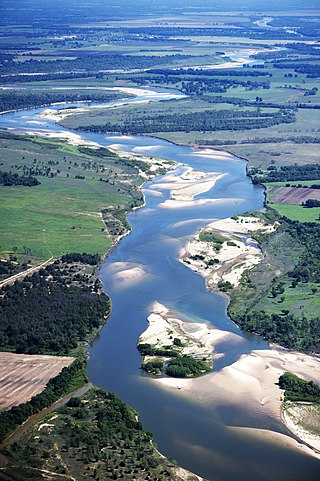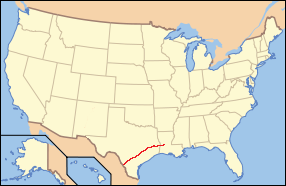
The Sabine River is a 360-mile (580 km) long river in the Southern U.S. states of Texas and Louisiana, From the 32nd parallel north and downstream, it serves as part of the boundary between the two states and empties into Sabine Lake, an estuary of the Gulf of Mexico.

Vernon Parish is a parish located in the U.S. state of Louisiana. As of the 2020 census, the population was 48,750. The parish seat is Leesville. Bordered on the west by the Sabine River, the parish was founded in 1871 during the Reconstruction era.

Sabine Parish is a parish located in the U.S. state of Louisiana. As of the 2020 census, the population was 22,155. The seat of the parish is Many.

Beauregard Parish is a parish located in the U.S. state of Louisiana. As of the 2020 census, the population was 36,549. The parish seat is DeRidder. The parish was formed on January 1, 1913.

Vinton is a town in Calcasieu Parish, Louisiana, United States. The population was 3,400 in 2020. It is part of the Lake Charles metropolitan statistical area.

Logansport is a town in western DeSoto Parish adjacent to the Sabine River in western Louisiana, United States. The population was 1,340 in 2020. It is part of the Shreveport–Bossier City metropolitan statistical area.

The Red River, or sometimes the Red River of the South, is a major river in the Southern United States. It was named for its reddish water color from passing through red-bed country in its watershed. It is known as the Red River of the South to distinguish it from the Red River of the North, which flows between Minnesota and North Dakota into the Canadian province of Manitoba. Although once a tributary of the Mississippi River, the Red River is now a tributary of the Atchafalaya River, a distributary of the Mississippi that flows separately into the Gulf of Mexico. This confluence is connected to the Mississippi River by the Old River Control Structure.

Sabine Lake is a bay on the Gulf coasts of Texas and Louisiana, located approximately 90 miles (140 km) east of Houston and 160 miles (260 km) west of Baton Rouge, adjoining the city of Port Arthur. The lake is formed by the confluence of the Neches and Sabine Rivers and connects to the Gulf of Mexico through Sabine Pass. It forms part of the Texas–Louisiana border, falling within Jefferson and Orange Counties in Texas and Cameron Parish, Louisiana.

The Calcasieu River is a river on the Gulf Coast in southwestern Louisiana. Approximately 200 miles (320 km) long, it drains a largely rural area of forests and bayou country, meandering southward to the Gulf of Mexico. The name "Calcasieu" comes from the Indian Atakapa language katkosh, for "eagle", and yok, "to cry".

The Neutral Ground was a disputed area between Spanish Texas and the United States' newly acquired Louisiana Purchase. Local officers of Spain and the United States agreed to leave the Neutral Ground temporarily outside the jurisdiction of either country. The area, now in western Louisiana, had neutral status from 1806 to 1821.

Los Adaes was the capital of Tejas on the northeastern frontier of New Spain from 1721 to 1773. It included a Franciscan mission, San Miguel de Cuellar de los Adaes, and a presidio, Nuestra Señora del Pilar de Los Adaes. The name Adaes derives from the indigenous Adai people, members of the Caddoan confederacy of Indians who were the people the missionaries aimed to convert to Christianity. The presidio and mission were established to counter French influence in Louisiana territory and defend New Spain from possible invasion or encroachment by the French. In 1763 Louisiana came under the control of Spain and the Los Adaes outpost was no longer necessary for defense. In 1773 the Spanish closed the mission and presidio and forced the population to move to San Antonio.

Louisiana Highway 8 is a state highway in Louisiana. It spans 156 miles (251 km) beginning at the Louisiana/Texas state line west of Leesville and ending at an intersection with U.S. Route 425 and LA 15 in Sicily Island.

The El Camino Real de los Tejas National Historic Trail is a national historic trail covering the U.S. section of El Camino Real de Los Tejas, a thoroughfare from the 18th-century Spanish colonial era in Spanish Texas, instrumental in the settlement, development, and history of Texas. The National Park Service designated El Camino Real de los Tejas National Historic Trail as a unit in the National Trails System in 2004.

Caddo Lake State Park is a state park located in the piney woods ecoregion of East Texas. The park consists of 484 acres (196 ha) on Big Cypress Bayou, west of Caddo Lake itself, in Harrison County, near Karnack, Texas. The park opened in 1934 and is managed by the Texas Parks and Wildlife Department. There are two separate units, Caddo Wildlife Management Area and Caddo Lake National Wildlife Refuge, nearby.

Burr's Ferry Bridge is a bridge on the Sabine River, where Louisiana State Highway 8 meets Texas State Highway 63 at the Louisiana/Texas state border between Burkeville, Texas, and Burr Ferry, Louisiana.

Louisiana Highway 111 (LA 111) is a state highway located in western Louisiana. It runs 45.72 miles (73.58 km) in a general north–south direction from U.S. Highway 190 (US 190) in Junction to LA 117 northeast of Leesville.
Gaines Ferry was a ferry on the Sabine River, between what is now Sabine Parish, Louisiana and Sabine County, Texas, at the eastern terminus of Texas State Highway 21, and the western terminus of LA 6. Much of the early history of New Spain, France, Mexico, the Republic of Texas, the United States, including the American Civil War, and the U.S. states of Texas and Louisiana, involve some aspect of Gaines Ferry. It was a major highway to the west and cattle trail east, a port of entry for the Republic of Texas, and a transportation road for military supplies and soldiers during the American Civil War that included transporting cotton to Mexico. Gaines Ferry was the northern entry for many colonists heading to Texas, and it was named after James Gaines who purchased it in 1819. The ferry saw continuous service until 1937.
Almadane is an unincorporated community in Vernon Parish, Louisiana, United States. The community is located 3 miles to the south of Evans and 13 miles west of Rosepine on the western edge of Clear Creek Wildlife Management Area on the scenic Myths and Legends Byway.
Clear Creek Wildlife Management Area is a 54,269-acre tract of protected area located in Vernon Parish, Louisiana. The Louisiana Department of Wildlife and Fisheries (LDWF) leases the land from Hancock Timber.





















